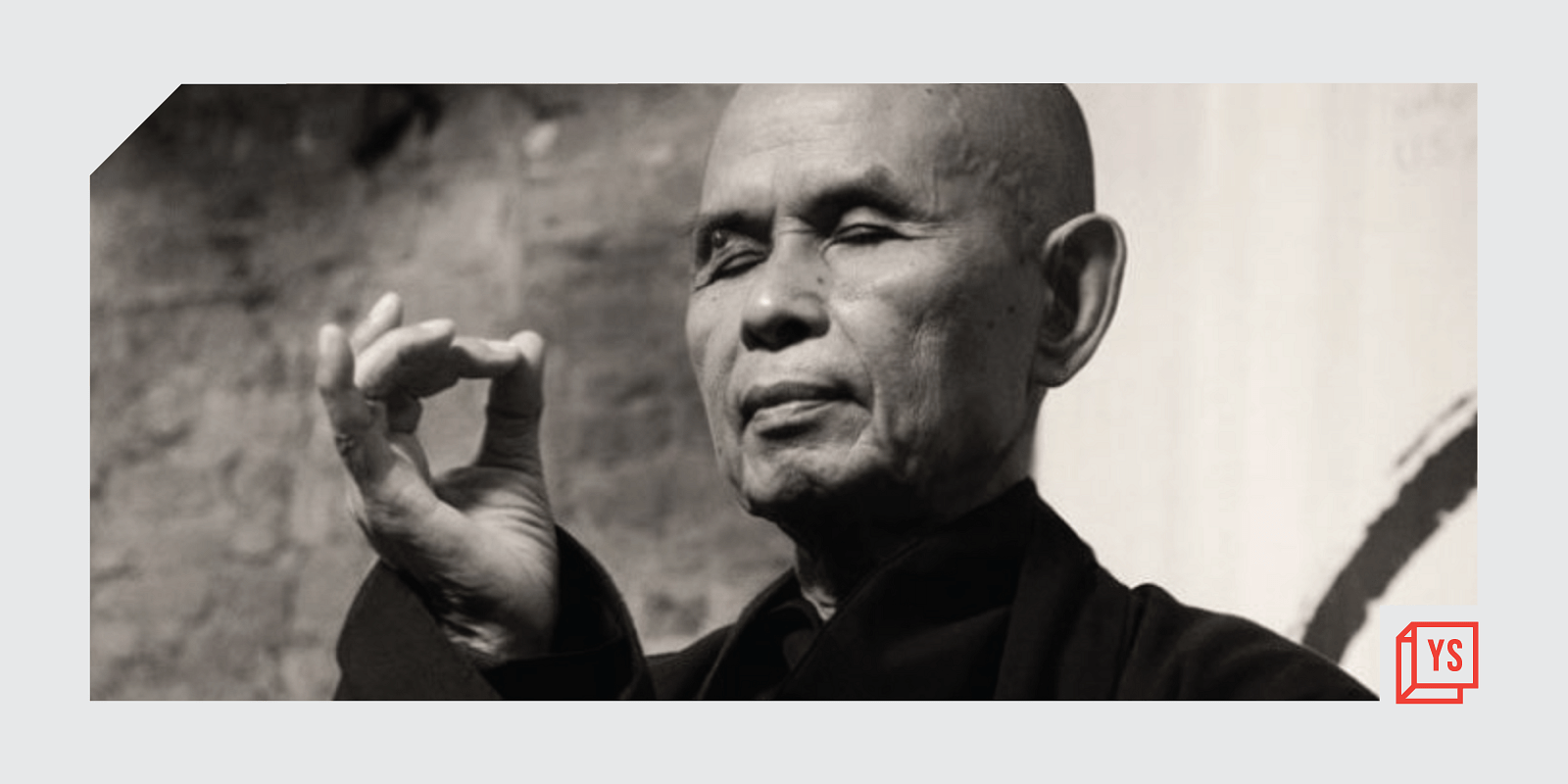Vietnamese Buddhist monk Thich Nhat Hanh, the Zen master par excellence loved by millions of disciples, departed this life on Saturday at his home in the Tu Hieu Temple in Hue, Vietnam. The global peace activist, who was 95 at the time of his passing, has left behind a treasure trove of messages on love, compassion, and the power of “true mindfulness” – something that many entrepreneurs and global tech leaders can practice every day to build sustainable businesses that create positive change in this world.
The death was announced by Plum Village, his organisation of monasteries in France, which said that “he continued to offer the Dharma and inspiration through his peaceful, serene and valiant presence”. (In the year 2014, a little after his 88th birthday, Thich Nhat Hanh suffered a severe stroke leaving him unable to speak).
The monk who inspired the world to meditate for peace; the monk who modernised the code of ethics globally through his “Five Mindfulness Trainings”; the monk who moved global leaders at Google, The World Bank, and the Harvard School of Medicine to ruminate on the principles of world peace and on building companies that are a force for good in the world; the monk who inspired the Western world to embrace the Zen way of life… there are so many epithets that could be used to describe the poet, teacher, author, and spiritual leader.
And yet, none could perhaps sum up the true essence of his life and time, for the supreme quality of Thich Nhat Hanh remains that he reigned as an everlasting emotion, inspiring people to believe in the power of togetherness, joy and compassion despite the tyranny of everyday miseries. To invest in the potential power of peace and compassion over and above the addictive spell of war and violence.
The life of the spiritual master
Born in central Vietnam in 1926, Thich Nhat Hanh was only 16 when he entered Tu Hieu Temple, in Hue city, as an amateur monk or a young bhikshu. In the early 1950s, he engaged in the movement to renew Vietnamese Buddhism.
During the Vietnam war, monks and nuns were confronted with a worldly dilemma – whether to continue to adhere to the meditative way of monastery life, or to turn activists on street to help those around them suffering under the bombings and the violence unleashed by the war.
In a departure from a traditional role associated with the monastic way of life, Thich Nhat Hanh chose to do both, setting a precedent befitting the visionary spiritual leader. He founded the Engaged Buddhism movement, coining the term in his book Vietnam: Lotus in a Sea of Fire.
In 1961, Thich Nhat Hanh travelled to the United States on a scholarship to study Comparative Religion at Princeton Theological Seminary and the following year went on to teach and research Buddhism at Columbia University. In Vietnam in the early 1960s, Thich Nhat Hanh founded the School of Youth and Social Service, a grassroots relief organisation of 10,000 volunteers. The volunteers were inducted to practise the “Buddhist principles of non-violence and compassionate action.”
A few months later he travelled once more to the US and Europe as an advocate of peace calling for an end to the Vietnam violence. It was during this 1966 trip that he first met Dr Martin Luther King, Jr, who nominated Thich Nhat Hanh for the Nobel Peace Prize in 1967. As a result of this mission, both North and South Vietnam denied him the right to return to Vietnam and he began a long exile of 39 years. Dr Martin Luther King addressed the master of compassion as the “apostle of peace and nonviolence.”
Plum Village, the paradise of peace
Throughout his life, Thich Nhat Hanh taught and wrote on the art of “mindfulness” and “living peace.”
In the early 1970s, he was appointed a lecturer and researcher in Buddhism at the University of Sorbonne, Paris. Five years later, he established the Sweet Potato community near Paris, which moved to a much larger site in the south west of France in 1982. It later came to be known as “Plum Village.”
Thich Nhat Hanh’s spiritual leadership led Plum Village to prosper into an enduring legacy of active Buddhism in the Western world. The community is the West’s largest and most active Buddhist monastery, with over 200 resident monastics and over 10,000 visitors every year, who come from around the world to learn “the art of mindful living.”
At Plum Village, people of all ages, backgrounds and faiths can learn practices such as walking meditation, sitting meditation, eating meditation, total relaxation, working meditation and stopping, smiling, and breathing mindfully. All of these are ancient Buddhist practices and the essence of the lifelong teachings of Thich Nhat Hanh.
The legacy of Thich Nhat Hanh
In the last 20 years, over 100,000 people have made a commitment to follow Thich Nhat Hanh’s modernised code of universal global ethics in their daily life, known as “The Five Mindfulness Trainings.”
Thich Nhat Hanh also founded Wake Up, a worldwide movement bringing together next-generation believers to practice the principles of mindful living.
In the last decade, Thich Nhat Hanh opened monasteries in California, New York, Vietnam, Paris, Hong Kong, Thailand, Mississippi and Australia, and Europe’s first “Institute of Applied Buddhism” in Germany.
He addressed the World Parliament of Religions in Melbourne and UNESCO in Paris, calling for a reversal of the vicious cycle of violence, war and global warming. On his visit to the US in 2013, he led high-profile mindfulness events at Google, The World Bank, and the Harvard School of Medicine.
In November 2018, Thich Nhat Hanh moved to Từ Hiếu Temple in his native Vietnam where he once embarked upon the journey of monkhood.
Continuing to stay in this abode of calm until he breathed his last on January 22, 2022, he stepped out regularly in his wheelchair to visit the temple altars and to lead the sangha on “walking meditation around the ponds and ancestral stupas”.
In his book No Death, No Fear, Thich Nhat Hanh wrote,
“The Buddha taught that there is no birth; there is no death; there is no coming; there is no going; there is no same; there is no different; there is no permanent self; there is no annihilation. We only think there is.”
This philosophy of the permanent or eternal self, the indomitable spirit of the human soul is one of the enduring strains of the vast ocean of wisdom that is Thich Nhat Hanh’s legacy.
And this legacy will continue to live on in the world of his believers – who are spreading the message of compassion and community bonding every day, urging cynics to rise above their hardened worldview – and closer home for us, among the many entrepreneurs, innovators, and tech leaders as they imbibe his teachings to build products and companies that are a force for good in this world and reimagine the world for a better tomorrow.
Source: PlumVillage.org






![Read more about the article [Product Roadmap] Heeding client feedback, how this supply chain SaaS startup developed solutions for logistical woes](https://blog.digitalsevaa.com/wp-content/uploads/2022/05/ImageEditorSuman18-1653404152832-300x150.png)



